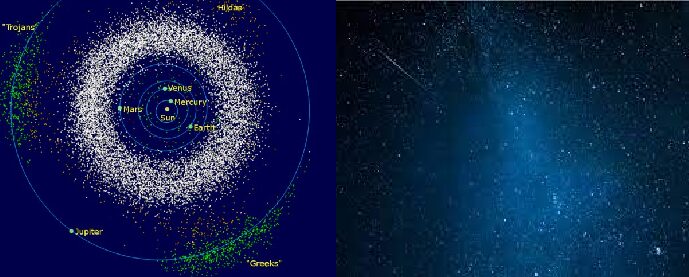Asteroid shares Earth’s orbit discovered- Could it help future space missions?

Earth, only the 2nd such entity ever seen, follows an asteroid barely a kilometer wide in its orbit around the Sun, according to research. It orbits the Sun 2 months ahead of Earth on normal, whirling about like an ecstatic harbinger of our arrival.
This object, dubbed 2020 XL5, was originally discovered in December 2020 utilizing Pan-STARRS telescopes on the Hawaiian island of Maui’s Haleakala mountain. However, defining its orbit necessitated additional observations with Chile’s 4.1-meter SOAR telescope.

Based on these findings, a team led by planetary scientists has revealed that 2020 XL5 will be locked in an orbit around one of the “Lagrange” Sun-Earth points for at minimum the next several 1000 years. The gravitational forces of the Sun and earth are balanced here, resulting in stable places. It signifies that the object rotates around the Sun at the same rate as the Earth.
Other planets have Lagrange points, which are equilibrium locations for any low-mass object influenced by two considerably more massive things. On the Sun-Earth line, there really are 3 such places (L1, L2, and L3), which were identified mathematical equations by the Swiss mathematician Leonhard Euler.
Joseph-Louis Lagrange, Euler’s disciple, discovered two further locations, L4 and L5, in 1772. A small mass object is in stable balance here, forming an equilateral triangle with the Earth and Sun. These sites are 60 ° ahead of and 60 ° behind Earth, which amounts to 2 months apart because 60 ° is 1/6th of the Orbit of the earth.

If a small-mass object is pushed away from L4 / L5, the Sun’s, as well as Earth’s joint gravitation, pulls back, bending into a stable orbit around Lagrange point that looks bean-shaped to the Earth.
XL5, but without fireball
By similarity with Jupiter’s Trojan asteroids, 2020 XL5 is known as Earth’s Trojan Companions. Jupiter is orbited by about 10,000 known asteroids, half of which are ahead of Jupiter as well as half of which are behind this one. The first of them, discovered in 1906, was called Achilles after a prominent figure in Homer’s Iliad’s siege of Troy.
The Lagrange points are a set of coordinates related to the Earth’s orbit (Sizes and distances not to scale).
Each was given the name of a hero from the same story, which became a convention. Only those who are closest to Jupiter (at L5) are given Trojan names, such as Hektor, while those closest to Jupiter (at L4) are given Greek names, such as Achilles. They’re all known as Trojans, whether they’re at L4 or L5.
Trojan asteroids connected with Neptune (23), Uranus (1), & Mars (9) have been detected in small numbers. However, 2020 XL5 is only the 2nd Trojan companion discovered from Earth. In 2010, the first, 2010 TK7, was identified.

As a result, it’s a sample of what the Solar System was founded on, and studying Earth’s fellow Trojans in greater depth as samples of unmodified material would be informative.
The positions of asteroids, with Jupiter Trojans in green.
Could we, on the other hand, remove them or utilize them in other ways?
2020 XL5 has an orbit that swings above as well as below Earth’s orbital plane, according to Santana-Ros. This implies that getting a spacecraft to a rendezvous (to orbit or land on it) would necessitate a significant speed adjustment. That would very certainly require far too much fuel to be practical. The same may be said for TK7 2010.
Read Also/OPPO Watch Free to launch in India on February 4 alongside Reno 7 series

Meanwhile, if other terrestrial Trojans are discovered in the less inclined orbits, they might serve as staging grounds for Solar System research, according to the study. Because their gravitational is so light, it would be considerably easier to lift off than from Earth or the Moon. They may even be a source of resources that we can exploit.
The discovery of a new Trojan asteroid on Earth has been confirmed by scientists.
The Conversation has given permission to reprint this article under a Creative Commons license.
Conclusion
Positions of asteroids, with Jupiter’s Trojans, are highlighted in green. There are likely many more Earth Trojans, although they are difficult to find from Earth because they can only be seen low in the sky before sunrise if they are at L4 like 2010 TK7 and 2020 XL5, or soon after sunset if they are at L5.
They can’t be remains that have been around since Earth’s origin but wandered into place later because their orbits aren’t steady over millions of years. The SOAR assumptions, on the other hand, revealed that 2020 XL5 appears to be a carbon-rich asteroid (called C-type). As a result, it’s a sampling of the materials used to construct the Solar System.






